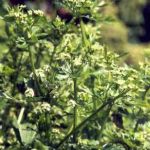| Common Name: |
Wild Celery |
| Other Names: |
Apium, Celery, Celery Seed, Marsh Parsley, Smallage |
| Botanical Name: |
Apium graveolens |
| Genus: |
Apium |
| Family: |
Umbelliferae |
| Location: |
Southern Europe, United States, Holland, Hungary, India, Europe, SW Asia, N Africa |
| Extraction: |
Steam Distillation |
| Parts Used: |
Seeds, Stalks, Whole Plant, roots, oil. |
| Color and Odor: |
The essential oil is pale yellow in color with a fresh, warm, sweet-spicy aroma. |
| Background: |
Celery was known to the ancient Greeks and was later used by Western Europeans as a cultivated vegetable. Another variety of celery is the celeriac root vegetable. |
| Cultivation: |
Rich, damp soil in a sheltered position in sun or partial shade. Tolerates saline soils. Apium graveolens is less prone to pests and diseases than the cultivated variety, but may be damaged by slugs, celery-fly maggots, celery leafspot, and mosaic virus. It fruits better in a warm climate. |
| Propagation: |
By seed sown in spring at 13-16°C (55-61°F). Seeds sold for cultivation as a vegetable may be treated with fungicides and should not be used for medicinal purposes. |
| Harvest: |
Whole plants are harvested when fruiting and liquefied to extract the juice. Roots are dug in autumn and used fresh, or dried for use in tinctures. Seeds are collected as they ripen, and dried for infusions, liquid extracts, and powders, or distilled for oil. |
| Height: |
30cm-1m (1-3ft) |
| Width: |
15-30cm (6-12in) |
| Hardiness: |
Z7-9 |
| Properties: |
Carminative, diuretic, sedative, hypotensive, tonic, antirheumatic.
An aromatic, bitter, tonic herb that reduces blood pressure, relieves indigestion, stimulates the uterus, and has diuretic and anti-inflammatory effects. Sedative and aphrodisiac effects have also been reported. |
| Planet: |
Mercury |
| Element: |
Air |
| Magical Influences: |
Psychic Awareness, Sleep. |
| Uses: |
- Digestive Sytem—Useful in expelling wind and relieving a bloated stomach.
- Urinary System—Promotes the flow of urine; clears the body of toxins. Decreases puffiness due to water retention. It is also antiseptic, therefore good for combating cystitis.
- Circulatory Sytem—Helpful for high blood pressure.
- Reproductive System—Helpful in menstrual problems, as it clears obstructions.
- Skeletal System—Dissolves toxic accumulations in the joints, relieving rheumatic and arthritic problems.
- Emotions—Helps to induce cheerfulness after a tiring day. Clears the mental clutter and reduces anxiety.
|
| Medicinal Uses: |
To treat loss of appetite, exhaustion, gout, kidney stones, gallstones, nervous agitation, rheumatism; to regulate the bowels; as a diuretic.
Internally for osteo-arthritis, rheumatoid arthritis, gout, and inflammation of the urinary tract. Externally for fungal infections and tumors (oil). It is often combined with Guaiacum officinale (see lingum vitae) and Menyanthes trifoliata (see bog bean) for rheumatic complaints, and with Taraxacum officinale (see dandelion) to increase its potency. Internally in Ayurvedic medicine, for asthma, bronchitis, hiccups, and gas, and as a stimulating nerve tonic. Not given to pregnant women. |
| Typical Dose: |
A typical dose of celery may range from 1 to 4 gm of seeds per day. |
| Possible Side Effects: |
No side effects have been recorded when celery is taken in recommended therapeutic doses. |
| Blends: |
| DIGESTIVE |
URINARY |
CIRCULATORY |
| Celery 6 |
Celery 6 |
Celery 6 |
| Melissa 4 |
Juniper 5 |
Rose 3 |
| Peppermint 2 |
Rosemary 2 |
Ylang-Ylang 2 |
|
| REPRODUCTIVE |
SKELETAL |
EMOTION |
| Celery 6 |
Celery 7 |
Celery 6 |
| Rosemary 4 |
Rosemary 3 |
Rosewood 3 |
| Rose 3 |
Marjoram 3 |
Orange 2 |
| Drug Interactions: |
| Taking celery with these drugs may increase skin sensitivity to sunlight: |
| Bumetanide, (Bumex, Burinex) |
Ciprofloxacin, (Ciloxan, Cipro) |
Doxycycline, (Apo-Doxy, Vibramycin) |
Enalapril, (Vasotec) |
Etodolac, (Lodine, Utradol) |
| Fluphenazine, (Modecate, Prolixin) |
Fosinopril, (Monopril) |
Furosemide, (Apo-Furosemide, Lasix) |
Gatifloxacin, (Tequin, Zymar) |
Hydrochlorothiazide, (Apo-Hydro, Microzide) |
| Ibuprofen, (Advil, Motrin) |
Indomethacin, (Indocin, Novo-Methacin) |
Ketoprofen, (Orudis, Rhodis) |
Ketorolac, (Acular, Toradol) |
Lansoprazole, (Prevacid) |
| Levofloxacin, (Levaquin, Quixin) |
Lisinopril, (Prinivil, Zestril) |
Loratadine, (Alavert, Claritin) |
Methotrexate, (Rheumatrex, Trexall) |
Naproxen, (Aleve, Naprosyn) |
| Nortriptyline, (Aventyl HCL, Pamelor) |
Ofloxacin, (Floxin, Ocuflox) |
Omeprazole, (Losec, Prilosec) |
Phenytoin, (Dilantin, Phenytek) |
Piroxicam, (Feldene, Nu-Pirox) |
| Prochlorperazine, (Compazine, Compro) |
Quinapril, (Accupril) |
Risperidone, (Risperdal) |
Rofecoxib, (Vioxx) |
Tetracycline, (Novo-Tetra, Sumycin) |
| Taking celery with these drugs may be harmful: |
| Fondaparinux, (Arixtra)—may increase risk of bleeding or bruising. |
Levothyroxine, (Levothroid, Synthroid)—may reduce effectiveness of the drug. |
|
| Lab Test Alterations: |
Celery seed may decrease thyroxine (T-4) serum levels. |
| Disease Interactions: |
May worsen kidney ailments by triggering inflammation. |
| Culinary Uses: |
Wild celery is rarely used for culinary purposes because of its bitterness - and toxicity in large amounts - although the seeds may be used in small quantities to flavor soups and stews, or mixed with dehydrated salt. |
| Bibliography: |
Encylopedia of Herbs by Deni Brown Copyright ©: 1995, 2001 Dorling Kindersley Limited pg 125
Aromatherapy Blends and recipes by Franzesca Watson Copyright © 1995 Thorsons, Harper Parker Publishing Inc. Pp 80-81
Magical Aromatherapy by Scott Cunningham Copyright © 1989 Llewellyn Publications, Inc. Pp 72-73
The Essential Herb-Drug-Vitamin Interaction Guide by Geo. T. Grosberg,MD and Barry Fox,PhD Copyright ©2007 Barry Fox,PhD. Pp.139-140 |
|

